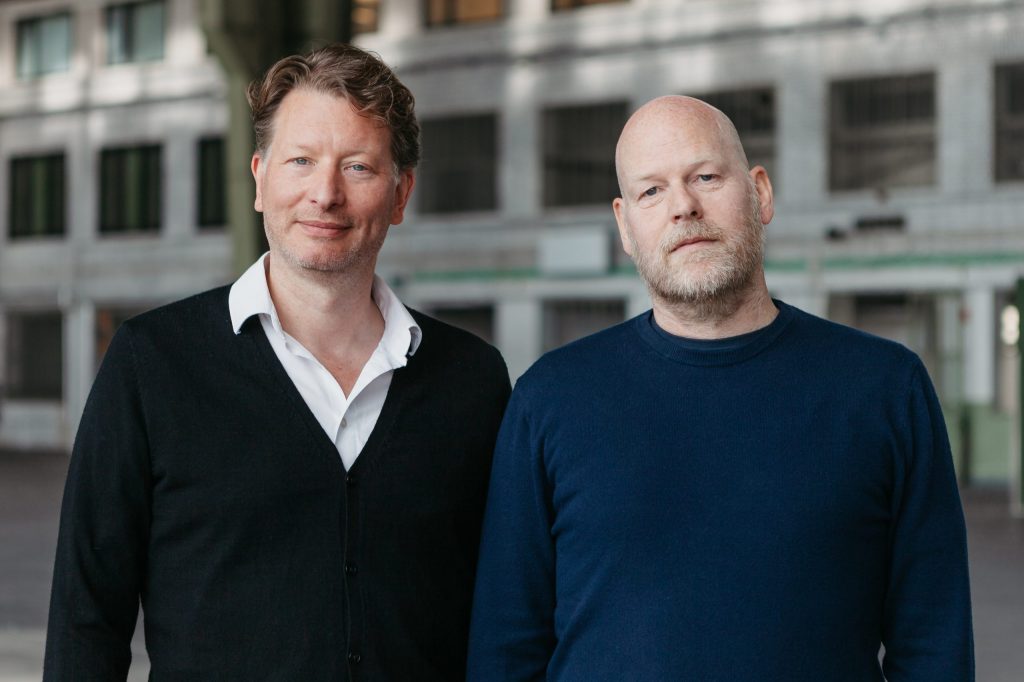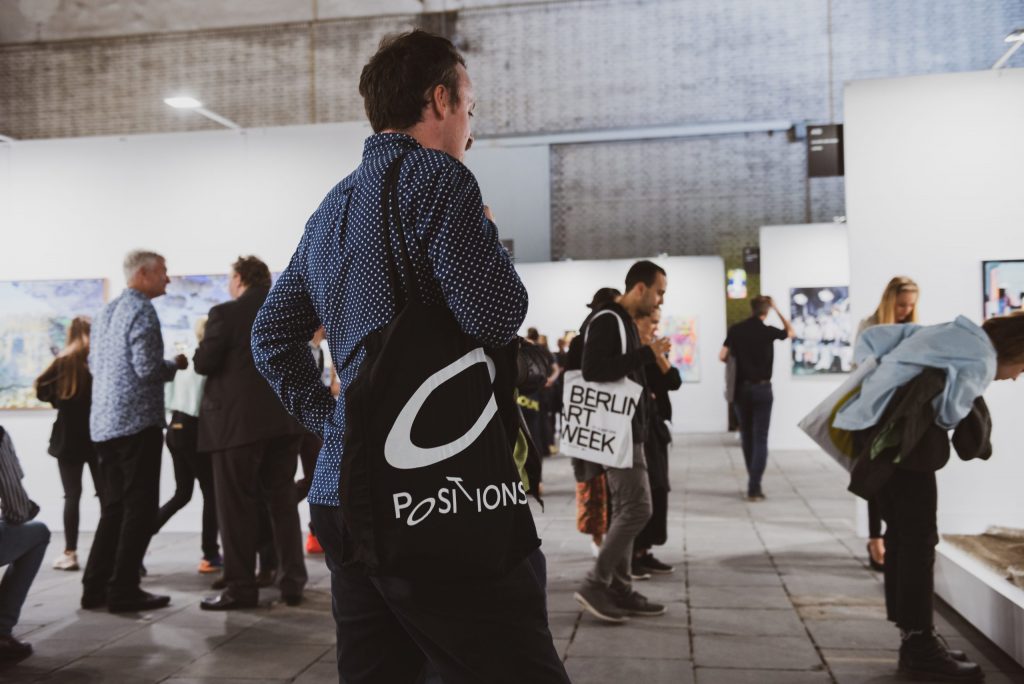POSITIONS Berlin: Face to Face

Heinrich Carstens and Kristian Jarmuschek, Directors of POSITIONS Berlin Art Fair met in 2012 when they were both gallery owners, and very quickly developed a synergetic partnership. Jarmuschek was working on an art fair that was on the verge of being cancelled, but couldn’t bear for that to happen. He called Carstens who had only just left the gallery he was working for, and so POSITIONS Berlin Art Fair and Paper Positions were born. For the past six years the exhibitions have championed young international artists and given galleries easy access to the market.

Photo credit: Clara Wenzel-Theiler
Co-director Heinrich Carstens talks to FRONTRUNNER about the future of the fairs and to find out more about his vision for the art world.
For the very first POSITIONS, you had just two and a half months to make it work. How much did you think about the fair reflecting the pulsing life of Berlin and how you could nourish the work of young artists?
We had a very rotten building, although a very famous building. Everyone knew it from the outside, but never from the inside, Kaufhaus Jandorf. Everyone was so curious to see it from the inside. Our idea was to see it as a big party in this rotten place, with fantastic art there. So it was about making a three day party that reflects the Berlin style. We didn’t expect it to be successful, but it really was, so after being a team of just four people for the first two years, we decided to go on. Also, it was a bit boring to do just one a year, so we looked at [Berlin] Gallery Week. Then we tried a few things that didn’t work out, but you know it’s all about experimentation.
After the success of the first art fairs and your hunger to do more than one show, how did things evolve?

Photo credit: Clara Wenzel-Theiler
In 2016 we decided to make another exhibition, and somebody offered us a really small space. I mean it was too small to show sculptures or canvasses, or anything like that. And so it became paper positions by accident. We decided to do something with smaller works and focus on the material. That was the only way that the space would work, with maybe 23 or 24 Berlin galleries and we did not expect to have any visitors at all, to be totally honest with you. It was so packed and we sold 50% of the works. We had no money but wanted to do this internationally – so we decided to make an art fair out of it – and we don’t want more than 50 galleries you know. We like the idea of a salon, and that our visitors have the feeling that they are in a group exhibition rather than an art fair.So now we do it in Munich, Frankfurt, and Basel. The space is always very important for us, “Berlin style” we call it. We always wanted to share this. When we find a location it’s always about walking in and feeling it. We are always scouting. Obviously you need a minimum space for storage, ticketing, installing walls etc, but you will never find us in a boring trade building. One time in Munich we had a bank building with a really special atmosphere, and that really worked for the Berlin crowd. When you find the right space, you know within like 15 seconds of walking in.
With success in various cities and all that we’re going through globally, how are you responding to the huge uncertainty? Are you hopeful for the future and the role that art in communities might play?
Well everything is different for all of us, right? We were meant to open in April and obviously we haven’t been able to, so there are a lot of questions with exhibitors around money, for example. It’s tough. We are trying to make plans for Autumn, but then at the same time you can’t really make plans. Rather than art we are focused on surviving. Then again, when things do reopen, in Berlin I don’t see it being an issue. There are no crowds in galleries here, even at the weekend if there are five visitors a day then that’s a good day in Berlin, so they can definitely handle opening again. We are living in a different way now, and you meet people differently too. Personally, I hate being inside, I’ve definitely been close to killing my family! But for the future you know we have to be positive…
POSITIONS is all about showcasing international artists in a typical Berlin way: off the beaten track. Let’s talk about the artists themselves. How does their world look and what have your conversations been about?
Well, they are really suffering, particularly the young artists; they are unsure of how to survive as they can’t do any of the other jobs they might do to support their careers. I mean, even if some of us get financial support from the government, it may only help for a few months, but what about the rest of the year? Any other job that a young artist might have, those have all stopped. We are doing more social media and podcasts with them and, of course, we are talking all the time with them but we cannot do anything – and that is stressful.
In our realm, we talk and then we want to act, and now there is this queue of ideas waiting to be realised. We are all the same, we go from being totally depressed one day, to having great ideas the next, and suddenly feeling optimistic again, and that’s how we all are. We are in a constant state of emotional change. For us, the current plan is to do two fairs in one building and we can’t wait to realise that and be working with artists once again.
How will you be able to accomplish that? Doesn’t it throw up a whole bunch of challenges?
Well, as a visitor there is a difference between the two fairs and you can see that. We can’t have more staff, so that’s definitely the challenge, at the moment. We aren’t the only fair that’s had to delay. All the Basel fairs, Paris, London have all had to postpone, and it means that everywhere is focusing on September. Say there are fifteen art fairs in September, how will that work with exhibitors? Sadly, not every gallery will survive, and there are exhibitions that we are all missing.
What is exciting is that it’s all about combinations, and that’s what we are. Sometimes it’s tricky maybe when a gallery might offer you a couple of artists that you just don’t see within the mix that you’re visualising. Most of the galleries know and trust us and that’s okay; it’s all about the interesting combination of artists and artwork. Name dropping is not so interesting to us. There are so many special artists and that’s what’s compelling to us. We try to find the positive in the challenge and with some amazing blends of art we will be so happy if we can have the art fair this year. After all, POSITIONS was named that because it’s all about the mixing, the blending, and the relationship of the different works and artists at the fair. For me art is essential, it’s my life, it’s not a job.
You’re creating an exhibition and you’ve got that perfect mix of international artists, everything is working in harmony. How much time do you spend considering the collectors and the sort of people that you want to come to the show?

Photo credit: Clara Wenzel-Theiler
In our head, there is the image of the perfect art world. That would mean a young artist meets a young gallerist, they meet a young collector, and they work for some years together, because they can learn from each other and support each other. Actually, I think they don’t have to be young, but perhaps to be from the same generation; to have the same mood, education, interests, whatever. So, this would be the Paradise. If we don’t do it, well who should do that? So we are always working on the idea of getting that combination together. We try to support young galleries with young artists, and we’re working really hard when someone has an interest in art and has the funds, but maybe they have never bought an art work before. Kristian and I do a lot of private guided tours and try to share our passion.You know everybody was talking about Berlin, that it’s a great place for art, but there are not enough collectors. That’s not true. There are a lot of people with a lot of money. These guys have so much money you know, they take like two days to decide whether to buy a 100,000 euro car, and then they take weeks to buy a 2,000 euro painting. Isn’t that crazy?! Once you have helped them to buy the first artwork, then after that it’s much easier.
A lot of people are so shy to enter a gallery or talk about art, as they think maybe they are not good enough to talk about it, but that’s bullshit. Everyone can talk about their feelings and what they see. This is what we love to do with our private tours, it’s on us to talk about art, show them what we like, what we don’t, and show them that it’s not a holy thing. It’s just art. You can touch it. You can live with it. And if you like it buy it. If you come back two days later and it’s sold, it’s horrible.